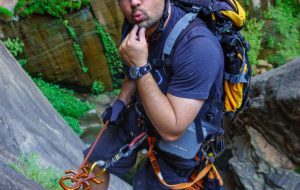Systems administrator captures beauty of national parks
October 27, 2020
In one of Joe Braun’s favorite photos, the rising sun casts soft pink light over the rocky shoreline of Little Hunters Beach in Acadia National Park.
Braun has captured thousands of stunning images over the years. But he’s not just a talented photographer — he has used his vast knowledge of U.S. national parks to create helpful guides for hikers in the hope that they will enjoy their visits to the parks as much as he does.
“I want people to love what they see in nature, and also to respect and preserve these special places,” said Braun, a senior systems administrator at U-M’s Institute for Social Research.
Braun has enjoyed hiking and exploring for as long as he can remember. As a child, his parents took him on summer road trips in an Airstream camper to national parks across the country.

Joe Braun, a senior systems administrator at the Institute for Social Research, rappels in Mystery Canyon in Zion National Park in 2016. Braun enjoys hiking and exploring and is also a talented photographer. (Photo courtesy of Joe Braun)
“I would see a map of a park and see a network of trails, and I would instantly want to see and hike every trail on the map,” Braun said.
Braun also began to dabble in photography at an early age. His time as a college student in U-M’s School of Music, Theatre & Dance helped him hone his craft.
“Composition training, music theory — all of that training has helped me with my photography because it teaches you how to think about your art, how to make things well-balanced, how to make sure that your art is trying to say something,” Braun said.
Today, Braun’s photography portfolio includes pictures of Detroit, Ann Arbor, the Finger Lakes in upstate New York and the Hocking Hills region of Ohio.
But the national parks, and two in particular — Zion and Acadia — are his favorite places to shoot.
“With Zion and Acadia, and somewhat Yosemite, I really know the place,” he said. “I know all of the trails, a lot of the peaks, a lot of the climbing routes. … With both of them, the scenery is so unique and so dramatic.”
Braun visits national parks two to four times a year. His trips range from laid-back family vacations to adventurous excursions, where he’s climbing steep rock faces and rappelling into canyons. He always brings a camera.
Braun sells his photography through a website he launched about 20 years ago, citrusmilo.com. The site also hosts the hiking guides he has created for three parks: Zion, Acadia and Yosemite.
The guides are jam-packed with information about park fees, weather, the best places to sleep and eat, and recommend hiking, backpacking and canyoneering routes. They also strongly encourage people to respect the parks and to practice “leave no trace” principles, which include not disturbing wildlife and not leaving any trash behind.
Braun’s guides have become a go-to source of information for park visitors. He updates them frequently so the information is always fresh.
“I enjoy being a useful resource,” Braun said. “There are a lot of people who email me and thank me for writing the website, and also ask interesting hiking and photography questions about the area. I enjoy it as a mechanism to meet and chat with fellow hikers and photographers.”
Braun’s favorite park is Zion National Park in southwestern Utah. His photography is featured on postcards and in books for sale in the park’s visitor centers.
In his guide to Zion, Braun calls the park, “the most awe-inspiring place on the planet.”
“From arid desert sections to breathtakingly majestic viewpoints to lush forests and claustrophobic slot canyons, there is a lot of beauty that most casual visitors never see,” he said.
Braun wrote on his website that his aesthetic as a landscape photographer is simple and straightforward: Try to capture interesting places and moments in time and show them to be as beautiful and inviting as possible.
“Since we can’t always be in the places we love, we can at least take the image with us to remember and share with others,” he said.
By Ann Zaniewski
The University Record
